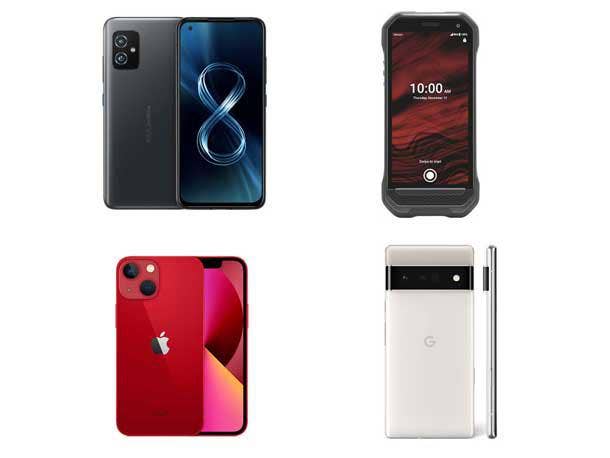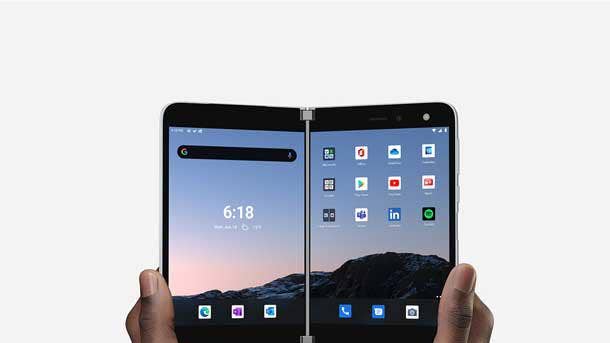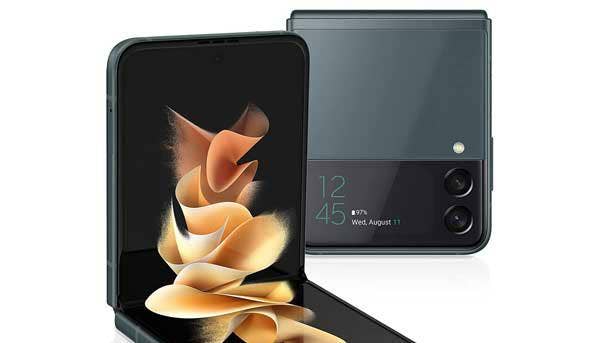The 10 Coolest New Phones Of 2021
CRN picks the 10 coolest smartphones of 2021, which includes premium models with adaptive refresh rates, telephoto cameras and even improvements in new form factor types.

120Hz Refresh Rates, Form Factor Improvements And More
This year saw the launch of several new smartphones that are setting the new standard for premium devices when it comes to displays, cameras and battery life, among other areas.
Out of the dozens if not hundreds of phones to come out in 2021, CRN has selected the 10 coolest new phones to release this year, and the group includes new standout models from Apple, ASUS, Google, Kyocera, Microsoft, OPPO, OnePlus and Samsung. Many of these phones feature refresh rates of 120Hz, and multiple models also sport telephoto cameras in addition to wide and ultra-wide cameras for greater photography freedom. One even promises the ability to shoot and display 1 billion colors.
[Related: The 10 Coolest IoT Devices And Products Of 2021]
While most of them continue the tried-and-true form factor of a single, continuous screen, a couple of them are offering improvements in new build types, like the dual-screen assembly of Microsoft’s Surface Duo 2 or Samsung’s Galaxy Z Flip 3, which combines the company’s folding screen technology with the flip phone form factor of yesteryear.

Apple iPhone 13 Mini
Apple’s iPhone 13 Mini provides a smaller form factor with many of the same features of the iPhone 13. The differences include the iPhone 13 Mini’s 5.4-inch OLED display, which is about 11 percent smaller than the iPhone 13. The iPhone 13 mini also has less battery life with Apple promising up to 17 hours of video playback, below the 19 hours of usage promised for the iPhone 13. Otherwise, the iPhone 13 Mini has the same set of features and specifications as its slightly larger sibling. This includes a brighter Super Retina XDR display, smaller notch and improved TrueDepth cameras compared to the iPhone 12 Mini. It also supports 5G connectivity and starts with 128GB of storage.

Apple iPhone 13 Pro Max
Apple’s iPhone 13 Pro Max provides a large, premium smartphone experience that promises up to 28 hours of battery life for video playback. The 6.7-inch display and long battery life are the phone’s two
main differentiators from the 6.1-inch iPhone 13 Pro, which provides six fewer hours of battery life. Otherwise, the iPhone 13 Pro Max shares the same features as its slightly smaller sibling: a ProMotion 120Hz refresh rate display, up to 1,000 nits of display of brightness, the A15 Bionic CPU, up to 1TB of storage, enhancements to the TrueDepth cameras and 5G connectivity support.

ASUS Zenfone 8
ASUS is pitching its Zenfone 8 as a powerful smartphone that fits in a “compact easy-to-handle package.” Powered by Qualcomm’s Snapdragon 888 5G mobile platform, the smartphone has a 5.9-inch AMOLED display with a 120Hz refresh rate, and it’s certified for IP68 water and dust resistance, giving the device extra protection against accidents. The Zenfone 8 is equipped with a dual-camera system that consists of a 64-megapixel wide-angle camera and a 12-megapixel ultrawide-angle camera. The front camera, on the other hand, has 12 megapixels. As for audio, ASUS is touting stereo speakers that “are driven by two of the most advanced audio amplifiers for higher volume, wider dynamic range, deeper bass and superb tonal balance.” Other features include up to 16GB of RAM and up to 256GB of storage.

Google Pixel 6 Pro
Google’s Pixel 6 Pro is the company’s new flagship 5G device that sports a 6.7-inch OLED display with 512 pixels per inch, 16 million colors and a refresh rate of up to 120Hz. The smartphone’s display is slightly bigger than the Pixel 6, and it can also support more RAM with up to 12GB and more storage with up to 512GB. The phone’s other differentiator from the smaller model is the addition of a 48-megapixel telephoto camera in addition to the 50-megapixel wide camera and 12 mega-pixel camera that are present on both phones. Its front camera also has a few more megapixels and a wider field of view. Both phones are powered by Google Tensor, a custom-built processor that provides advanced on-device AI and computational photography capabilities. They also both provide more than 24 hours of battery life based on mixed use and up to 48 hours using the Extreme Battery Saver feature.

Kyocera DuraForce Ultra 5G UW
The Kyocera DuraForce Ultra 5G UW is a rugged smartphone with high-speed 5G connectivity that is aimed at serving enterprise mobility needs. The smartphone’s 5.45-inch display is scratch-resistant, and it meets the military-standard 810H ruggedness certification, meaning the phone can survive drops of up to five feet onto concrete. It can also survive immersion in water, exposure from dust as well as extreme temperature and other conditions. Kyocera says this makes the DuraForce Ultra 5G UW the first “ultra-rugged” Android phone for the Verizon Ultra Wideband Network. The phone’s 5G connectivity provides fast speeds and “ultra-low latency” thanks to Qualcomm’s Snapdragon 765G mobile platform and
Snapdragon X52 5G Modem-RF System.

Microsoft Surface Duo 2
Microsoft’s Surface Duo 2 is a dual-screen smartphone that, when closed, displays color-coded badges on a glance bar to show how many calls and messages, including Teams chats, users have received, along with remaining battery. When fully open, applications like Outlook can span booth screens to, in this instance, enable quicker email browsing. The Surface 2 Duo can also act like a handheld game device, with the bottom screen acting as the controller and the other displaying the game. The smartphone’s two PixelSense Fusion displays are both 8.3 inches, and they each come with a 90Hz
refresh rate and a layer of nano-coated 3-D glass. The Surface Duo 2’s other features include 5G connectivity as well as a triple lens camera that can take high-quality photos and 4K video.

OPPO Find X3 Pro
Chinese smartphone vendor OPPO says its Find X3 Pro is the first smartphone that can display and capture 1 billion colors. The ultra-slim and lightweight phone comes with a 6.7-inch QHD+ OLED display, which has a resolution of 525 pixels per inch, an adaptive refresh rate of 5-120Hz and pops with colors thanks to OPPO’s full-path 10-bit Color Management System. The phone features wide and ultra-wide cameras, each of which has a 50-megapixel IMX766 sensor that was co-engineered with Sony. The Find X3 Pro is powered by Qualcomm’s Snapdragon 888 processor, and its 4500mAh battery reliably provides a day’s worth of power, according to OPPO.

OnePlus 9 Pro
The OnePlus 9 Pro features a stunning 6.7-inch AMOLED display with a 120Hz refresh rate and resolution of 525 pixels per inch — all of which is protected with Corning Gorilla Glass. The smartphone is slightly bigger than the 6.5-inch OnePlus 9, and its display can scale down to 1Hz to save on battery life when a higher refresh rate isn’t necessary. The OnePlus 9 Pro also features an 8-megapixel telephoto camera in addition to 48-megapixel main, 50-megapixel ultrawide and monochrome cameras that are also found in the smaller model — all of which were designed in collaboration with camera specialist Hasselblad. Both models come with storage of up to 256GB of storage and up to 12GB of RAM, and they support 5G connectivity.

Samsung Galaxy Z Flip 3
Samsung’s Galaxy Z Flip 3 combines the company’s folding screen technology with the flip phone form factor of yesteryear. As the successor to the original Galaxy Z Flip that debuted in 2020, the Galaxy Z Flip 3 provides a number of durability improvements, including a stronger frame and hinge, IPX8 water resistance and an 80 percent higher screen durability, thanks to its use of a new protective film and Gorilla Glass Victus. The Galaxy Z Flip 3 also has a 1.9-inch cover screen, which is four times larger than its predecessor, in addition to its 6.7-inch main display. Another improvement: Users can now shoot video from the cover screen while keeping the phone folded. The phone is powered by Qualcomm’s Snapdragon 888, with 8GB of RAM included, and it supports both types of 5G.

Samsung Galaxy S21 Ultra 5G
Samsung’s Galaxy S21 Ultra 5G sports a vibrant 6.8-inch display with up to 1,500 nits of brightness, a resolution of 515 pixels per inch and a refresh rate that automatically adjusts between 10-120Hz to optimize both viewing quality and battery life. The smartphone comes with a quad-camera system and supports up to 100X zoom for even sharper photos and more shooting options. It also features Samsung’s S Pen stylus, a first for a Galaxy S device. Compared to the Galaxy S21+ and S21, the Galaxy S21 Ultra has a larger display, a higher range for refresh rate, a higher resolution front camera with 40 megapixels, two telephoto cameras instead of one, a wide-angle camera with a much higher resolution of 108 megapixels, up to 512GB of storage and a higher battery life of 81 hours for audio playback.